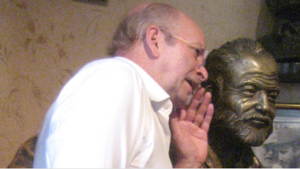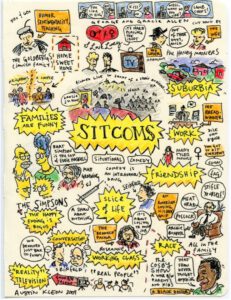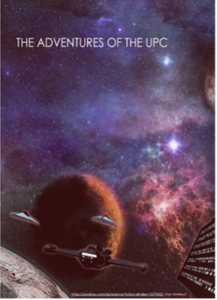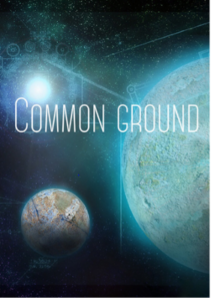If you want to go where no man has gone before, why not try your hand at collaborative writing? The idea is simple: Combine various types of writing in an elective course with a deep understanding of a specific theory. The seminar, “Where no man has gone before: Women and Science Fiction,” was my attempt to have students not only apply various forms of writing but also gain a deeper knowledge of intersectionality using social science fiction – with a dose of creativity. Just look at these student-produced project covers!
Tag Archives: Leuphana Universität Lüneburg
Chicana/o Quiz
In order to celebrate Cinco de Mayo, the – unfortunately not official – holiday of Mexican Americans in the United States, I’d like you to do the quiz and see how much you know about “la cultura chicana.”
Hemingway
I first read Hemingway at college in 1978, an intro course called Modern Existential Literature. The Old Man and the Sea was like looking at an x‑ray to see how we are put together. The Sun Also Rises was a look at how we fall apart. It was also a siren’s call: “This way, follow me.”

In spring 1980, I had five hundred bucks, a Eurail Pass and a backpack, and two months in which to see as much of Europe as I could. From Paris, following the characters from Sun, the train took me as far as Bayonne and from there it was thumb out. An old man named Jesus picked me up in a white car and drove me up the mountain to Pamplona. As a boy during the San Fermin festival, he had shaken Hemingway’s hand. When I got out of the car and he shook my hand, I was convinced if not a torch at least a spark had been passed.
Little Girl

The day started with a cold waft from a freezing night in the middle of March, as the warm light from the slowly rising sun filled the old but well-kept house of Mr. Parnell with brightness. It crawled from the kitchen sink over every cupboard to the empty wooden dining table and the flowered armchair in the lounge, paved its way to the frayed carpet in the small hallway and revealed the outlines of the main door, an inconspicuous iron gate, covered with branches and tendrils.
Although the house included a few more rooms, you could never see through the heavy drapes behind the windows, falling gravely from the curtain rods. Neither Mr. Parnell nor his little girl ever used the rooms, which were filled with antique furniture, old paintings, sculptures, and various collectables. Every little piece had its proper place, well ordered but in their sheer multitude simply unfathomable. The narrow basement, which was mostly used as a storage room for groceries, had another tiny window, but it was nothing more than a vent and way too small to let any light in or out.
Loving pro Virginia: A Films’ Powerfully Poignant Depiction of a Family’s Longing for Home
“I wanna move ’em back to the country.
I don’t care what they do to us.
I won’t raise my family here.”
The 2016 arthouse film Loving, directed by Jeff Nichols, has already run one hour and nine minutes before Mildred Loving expresses her unwillingness to comply with the court sentence that forbids the family to reside in their home state of Virginia. Her decision sets them on a path of no return. The route takes their case all the way to the U.S. Supreme Court. Loving v. Virginia will pave the way toward freely marrying, living, and loving for interracial couples in the United States (for couples, which fit hetero- and cisnormative standards, that is.) At first glance, the desire to return to Virginia might appear at odds with the violently hateful treatment Mildred and Richard Loving experienced at the hands of Virginian authorities amidst betrayal by one of their neighbors. At second glance, however, the film shows that the Lovings’ love for their home and home state is as much a driving force behind the struggle for equal rights as is their love for each other.
Mildred’s final decision to return to Virginia follows after their child Don is hit by a car in the busy Washington neighborhood. One of the most action-driven scenes in the otherwise strikingly calm and quiet movie, Don’s accident serves as the final tipping point, initiating the long journey of the Loving v. Virginia court case.
505 Hours and 45 Minutes of Comfort in Times of Uncertainty

505 hours and 45 minutes – that’s how long it takes to watch all of my favorite TV shows. Ever since the first nationwide lockdown began in Germany last March, I’ve been doing some serious re-watching. Among the shows I’ve been binging is the entire season of Friends (10), Parks and Recreation (7), The Office (9), Modern Family (10), How I Met Your Mother (9), New Girl (7), and Brooklyn 99 (8) – and some more than once.
According to The Huffington Post, watching something familiar triggers a feeling of nostalgia, which has a positive effect on your mental health. For instance, your mind may reconnect with the setting, the people you were with, or the feelings you had when you initially watched a certain episode. In my case, re-watching TV shows transports me back to the time before the pandemic.
I’ve always been someone to watch a good TV show multiple times or read a good book more than once. At this point, however, the rate at which I re-watch a film or show has reached a new height. Why is that? And what do all those TV shows have in common, apart from being successful American sitcoms?










